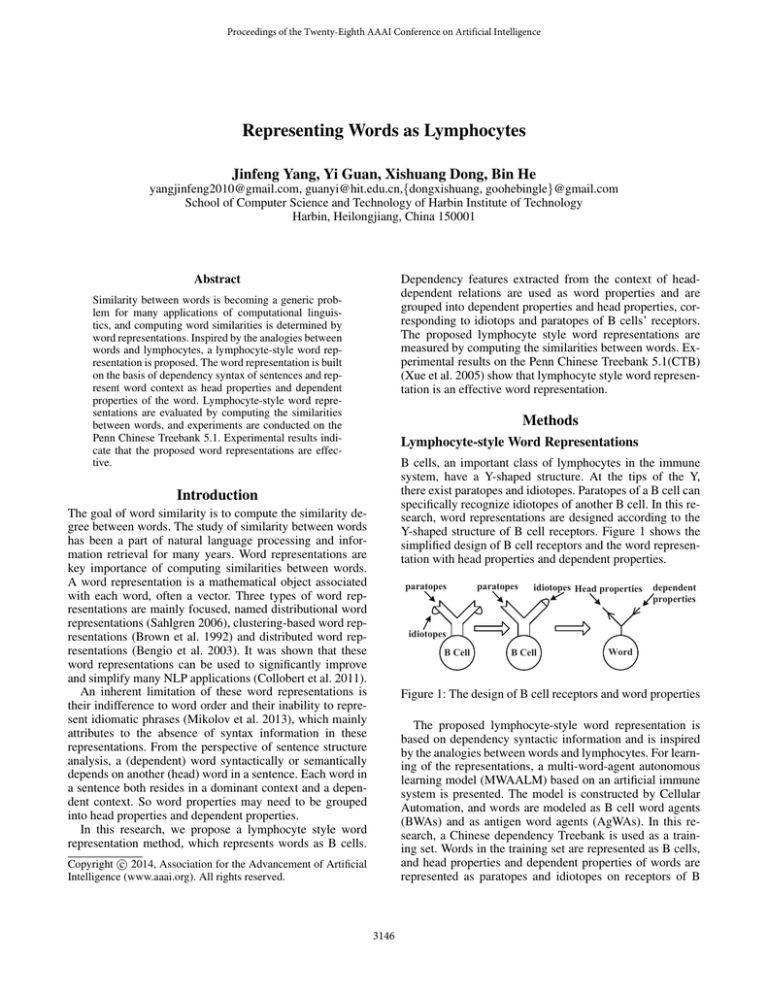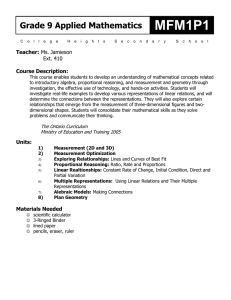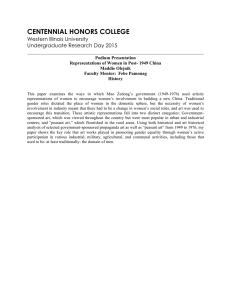
Proceedings of the Twenty-Eighth AAAI Conference on Artificial Intelligence
Representing Words as Lymphocytes
Jinfeng Yang, Yi Guan, Xishuang Dong, Bin He
yangjinfeng2010@gmail.com, guanyi@hit.edu.cn,{dongxishuang, goohebingle}@gmail.com
School of Computer Science and Technology of Harbin Institute of Technology
Harbin, Heilongjiang, China 150001
Abstract
Dependency features extracted from the context of headdependent relations are used as word properties and are
grouped into dependent properties and head properties, corresponding to idiotops and paratopes of B cells’ receptors.
The proposed lymphocyte style word representations are
measured by computing the similarities between words. Experimental results on the Penn Chinese Treebank 5.1(CTB)
(Xue et al. 2005) show that lymphocyte style word representation is an effective word representation.
Similarity between words is becoming a generic problem for many applications of computational linguistics, and computing word similarities is determined by
word representations. Inspired by the analogies between
words and lymphocytes, a lymphocyte-style word representation is proposed. The word representation is built
on the basis of dependency syntax of sentences and represent word context as head properties and dependent
properties of the word. Lymphocyte-style word representations are evaluated by computing the similarities
between words, and experiments are conducted on the
Penn Chinese Treebank 5.1. Experimental results indicate that the proposed word representations are effective.
Methods
Lymphocyte-style Word Representations
B cells, an important class of lymphocytes in the immune
system, have a Y-shaped structure. At the tips of the Y,
there exist paratopes and idiotopes. Paratopes of a B cell can
specifically recognize idiotopes of another B cell. In this research, word representations are designed according to the
Y-shaped structure of B cell receptors. Figure 1 shows the
simplified design of B cell receptors and the word representation with head properties and dependent properties.
Introduction
The goal of word similarity is to compute the similarity degree between words. The study of similarity between words
has been a part of natural language processing and information retrieval for many years. Word representations are
key importance of computing similarities between words.
A word representation is a mathematical object associated
with each word, often a vector. Three types of word representations are mainly focused, named distributional word
representations (Sahlgren 2006), clustering-based word representations (Brown et al. 1992) and distributed word representations (Bengio et al. 2003). It was shown that these
word representations can be used to significantly improve
and simplify many NLP applications (Collobert et al. 2011).
An inherent limitation of these word representations is
their indifference to word order and their inability to represent idiomatic phrases (Mikolov et al. 2013), which mainly
attributes to the absence of syntax information in these
representations. From the perspective of sentence structure
analysis, a (dependent) word syntactically or semantically
depends on another (head) word in a sentence. Each word in
a sentence both resides in a dominant context and a dependent context. So word properties may need to be grouped
into head properties and dependent properties.
In this research, we propose a lymphocyte style word
representation method, which represents words as B cells.
paratopes
paratopes
idiotopes Head properties
dependent
properties
idiotopes
B Cell
B Cell
Word
Figure 1: The design of B cell receptors and word properties
The proposed lymphocyte-style word representation is
based on dependency syntactic information and is inspired
by the analogies between words and lymphocytes. For learning of the representations, a multi-word-agent autonomous
learning model (MWAALM) based on an artificial immune
system is presented. The model is constructed by Cellular
Automation, and words are modeled as B cell word agents
(BWAs) and as antigen word agents (AgWAs). In this research, a Chinese dependency Treebank is used as a training set. Words in the training set are represented as B cells,
and head properties and dependent properties of words are
represented as paratopes and idiotopes on receptors of B
c 2014, Association for the Advancement of Artificial
Copyright Intelligence (www.aaai.org). All rights reserved.
3146
cells respectively. Dependency features extracted from headdependent relations are used as properties of words. For
w
} is the head
a word w, {hf1w , hf2w , · · · , hfiw , · · · , hfN
hf
feature set of w extracted from all head-dependent relations in which w is the head word and ωhfiw is the weight
w
of hfiw . Respectively, {df1w , df2w , · · · , dfjw , · · · , dfN
} is
df
the dependent feature set of w extracted from all headdependent relations in which w is the dependent word and
ωdfjw is the weight of dfjw . The paratopes P w and idiotopes
I w of a word w are formulated as Equation (1) and Equation
(2). Just like affinities between B cells, strength of dependency relation between two words can be determined, please
refer the section A2 of the Appendix1 for detail. Inspirations
from immune system and the learning of the representations
is discussed in the section A1 and A2 of the Appendix.
w
, ωhfNw )}
P w = {(hf1w , ωhf1w ), · · · , (hfN
P
(1)
w
, ωdfNw )}
I w = {(df1w , ωdf1w ), · · · , (dfN
I
(2)
P
I
the proposed lymphocyte-style word representation can be
successfully applied for word similarity computing and is
proven to be an effective word representation.
Table 1: The evaluation results of similar words.
Evaluator 1
Evaluator 2
PT op1
PT op5
PT op1
PT op5
0.6337 0.7864 0.6050 0.7840
Conclusions and Future Work
This research provides a completely new perspective on language and words. The important contribution is that a new
lymphocyte-style word representation is presented. With this
word representation, both similarities between words and
strengths of dependency relations can be determined. Two
aspects of future work will be mainly focused. One of the
future works is to adapt the model for a large scale data set
and make comparisons with other existing implementations
of word representations, such as word2vec. Another future
work is to try to apply the lymphocyte-style word representations to research tasks on NLP and to validate the performance of the word representations.
Similarity Based on Word Representations
The Distributional Hypothesis states that words that occur
in the similar contexts tend to have similar meanings (Harris 1954). We extend the Distributional Hypothesis: if two
words both share dominant contexts and dependent contexts,
the two words may be similar. Cosine similarity function
simcosine (x1 , x2 ) is adopted to measure the similarity of
both head properties and dependent properties. Based on
the lymphocyte style word representation, word similarity
can be computed according to equation (3). Distributional
similarity between words can induce the paradigmatic relation between words (Sahlgren 2006). Paradigmatic relations
are substitutable relations. So, the judgment about whether
two words are similar is determined by the judgment about
whether they share a paradigmatic relation.
similarity(w1 , w2 ) =
simcosine (P w1 , P w2 ) × simcosine (I w1 , I w2 )
References
Bengio, Y.; Ducharme, R.; Vincent, P.; and C.Janvin. 2003.
A Neural Probabilistic Language Model. J. Mach. Learn.
Res. 3:1137–1155.
Brown, P.; DeSouza, P.; Mercer, R.; and et al. 1992. Classbased N-gram Models of Natural Language. Comput. Linguist. 18(4):467–479.
Collobert, R.; Weston, J.; Bottou, L.; and et al. 2011. Natural Language Processing (Almost) from Scratch. J. Mach.
Learn. Res. 12:2493–2537.
Harris, Z. 1954. Distributional structure. Word 10(23):146–
162.
Mikolov, T.; Sutskever, I.; Chen, K.; and et al. 2013.
Distributed representations of words and phrases and their
compositionality. In Burges, C.; Bottou, L.; Welling, M.;
Ghahramani, Z.; and Weinberger, K., eds., Advances in Neural Information Processing Systems 26. Curran Associates,
Inc. 3111–3119.
Sahlgren, M. 2006. The word-space model: Using distributional analysis to represent syntagmatic and paradigmatic
relations between words in high-dimensional vector spaces.
Doctoral dissertation, Stockholm University.
Xue, N.; Xia, F.; Chiou, F.; and et al. 2005. The Penn Chinese TreeBank: Phrase structure annotation of a large corpus. Natural Language Engineering 11(2):207–238.
(3)
Experimental Results
A dependency Treebank, built from the CTB, is employed
as experimental data. For evaluation of the proposed word
representations, words in the first 100 sentences of the CTB
are considered. For each considered word, five words with
most high similarities, according to equation (3), are chosen
for evaluation. Two precision metrics are used to evaluate
those mined similar words. The one is the precision of top
one PT op1 , which means the percentage of those considered
words whose top one candidate word is judged similar. The
second is the precision of top five PT op5 , which means the
percentage of those considered words for which one of the
top five candidate words is judged similar. For the purpose
of impartial evaluation, two persons evaluated the candidate
similar words independently. Experimental results in detail
can be found in the section A3 of the Appendix.
As shown in table 1, the evaluation results by two persons seem to be in high agreement. The results indicate that
1
https://github.com/yangjinfeng/wordrep/blob/master/aaai2014
appendix.pdf
3147







